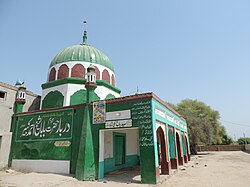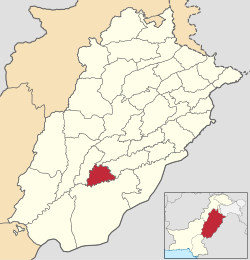Lodhran District
Lodhran District
ضِلع لودھراں | |
|---|---|
 Shrine of Sheikh Ahma Kabir | |
 Map ofPunjabwith Lodhran District highlighted | |
| Country | |
| Province | |
| Division | Multan |
| Headquarters | Lodhran |
| Government | |
| • Type | District Administration |
| •Deputy Commissioner | Abdul Rauf Mahar |
| • District Police Officer | Hassam Bin Iqbal |
| • Chief executive officer health | Faisal Waheed |
| Area | |
| • Total | 2,778 km2(1,073 sq mi) |
| Population | |
| • Total | 1,928,299 |
| • Density | 690/km2(1,800/sq mi) |
| Time zone | UTC+5(PST) |
| Number ofTehsils | 3 |
| Website | lodhran |
Lodhran District(Saraiki:ضِلع لودهراں), is adistrictin the province ofPunjab,Pakistan, with the city ofLodhranas its capital. Located on the northern side of the RiverSutlej,it is bounded to the north by the districts ofMultan,KhanewalandVehari,to the south byBahawalpur,to the east lie the districts of Vehari and Bahawalpur; while district Multan lies on the western side.
Lodhran was split off as a separate district fromMultanin 1991.[2]It has the lowestHuman Development Indexof all districts in Punjab, and is among the thirty poorest districts in Pakistan.[3]: 85 It is a well-known cotton-growing area.[2]
Administrative divisions
[edit]Lodhran District is spread over an area of 2,778 square kilometres and is subdivided into threetehsils(Lodhran,Kahror PakkaandDunyapur) which contain a total of 73Union Councils:[4]
| Tehsil | No. of Unions |
|---|---|
| Dunyapur[4] | 22 |
| Kahror Pakka[4] | 23 |
| Lodhran[4] | 28 |
| Total | 73 |
Demographics
[edit]| Year | Pop. | ±% p.a. |
|---|---|---|
| 1951 | 289,052 | — |
| 1961 | 363,563 | +2.32% |
| 1972 | 558,793 | +3.98% |
| 1981 | 739,912 | +3.17% |
| 1998 | 1,171,800 | +2.74% |
| 2017 | 1,699,693 | +1.98% |
| 2023 | 1,928,299 | +2.13% |
| Sources:[5] | ||
At the time of the 2017 census, Lodhran district had 262,629 households and a population of 1,699,693. Lodhran had a sex ratio of 973 females per 1000 males and a literacy rate of 49.88% - 61.61% for males and 38.08% for females. 265,601 (15.63%) lived in urban areas. 502,932 (29.59%) were under 10 years of age.[6]In 2023, the district had 324,020 households and a population of 1,928,299.[1]
| Religion | Population (1941)[7]: 62–63 | Percentage (1941) | Population (2017) | Percentage (2017) | Population (2023)[8] | Percentage (2023) |
|---|---|---|---|---|---|---|
| Islam |
175,642 | 82.59% | 1,695,600 | 99.76% | 1,917,852 | 99.56% |
| Hinduism |
33,246 | 15.63% | 93 | 0.01% | 97 | 0.01% |
| Sikhism |
3,519 | 1.65% | — | — | 24 | 0% |
| Christianity |
218 | 0.1% | 3,227 | 0.19% | 7,613 | 0.4% |
| Ahmadi | — | — | 710 | 0.04% | 656 | 0.03% |
| Others[c] | 49 | 0.02% | 63 | 0% | 93 | 0% |
| Total Population | 212,674 | 100% | 1,699,693 | 100% | 1,926,357 | 100% |
At the time of the 2023 census, 73.81% of the population spokeSaraiki,15.23%Punjabi,6.41%Urdu,and 2.19%Mewatias their first language.[10]
The most widely spoken first language isSaraiki(70%), which is used by the major indigenous social groups of the Joya, Baloch, Awan,Arain,Kanju, Uttera/Uttero, Ghallu, Bhutta, Lodhra, Metla, Chaner Syed,Qureshi,TareenandPathan.Additionally,Punjabiis spoken by about 19%. The percentage of the district's population who declaredUrduas their language at the 1998 census was 9%; this includes these Haryanvi speakers as well as other, smaller, groups of Muhajirs such as theMughal.Additionally, the nomadic Od people are speakers of theOd language,whilePashto(0.2%) is spoken byPashtuns.[11][3]: 83
Notes
[edit]- ^1941 figures are for Lodhran tehsil of Multan District, which roughly corresponds to present-day Khanewal district. Historic district borders may not be an exact match in the present-day due to various bifurcations to district borders — which since created new districts — throughout the historicPunjab Provinceregion during the post-independence era that have taken into account population increases.
- ^1941 census: IncludingAd-Dharmis
- ^IncludingJainism,Buddhism,Zoroastrianism,Judaism,or not stated
References
[edit]- ^ab"TABLE 1: HOUSEHOLDS, POPULATION, HOUSEHOLD SIZE AND ANNUAL GROWTH RATE"(PDF).www.pbscensus.gov.pk.Pakistan Bureau of Statistics.2023.
- ^abKhan, Ahmad Fraz (18 January 2021)."Multan's mangoes and multinationals".Dawn (newspaper).Retrieved5 April2023.
- ^abMughal, Muhammad Aurang Zeb (2014).Time, Space and Social Change in Rural Pakistan: An Ethnographic Study of Jhokwala Village, Lodhran District(Thesis). Durham University website.Retrieved5 April2023.
- ^abcd"Tehsils & Unions in the District of Lodhran".National Reconstruction Bureau, Government of Pakistan website.Archived fromthe originalon 7 August 2011.Retrieved5 April2023.
- ^"Population by administrative units 1951-1998"(PDF).Pakistan Bureau of Statistics.
- ^"District Wise Results / Tables (Census - 2017)".www.pbscensus.gov.pk.Pakistan Bureau of Statistics.
- ^"CENSUS OF INDIA, 1941 VOLUME VI PUNJAB PROVINCE".Retrieved21 July2022.
- ^"Pakistan Census 2023"(PDF).
- ^"District Wise Results / Tables (Census - 2023)"(PDF).www.pbscensus.gov.pk.Pakistan Bureau of Statistics.
- ^"Pakistan Census 2023"(PDF).
- ^Lodhran District - Population DetailsCitypopulation.de website, Retrieved 6 April 2023

